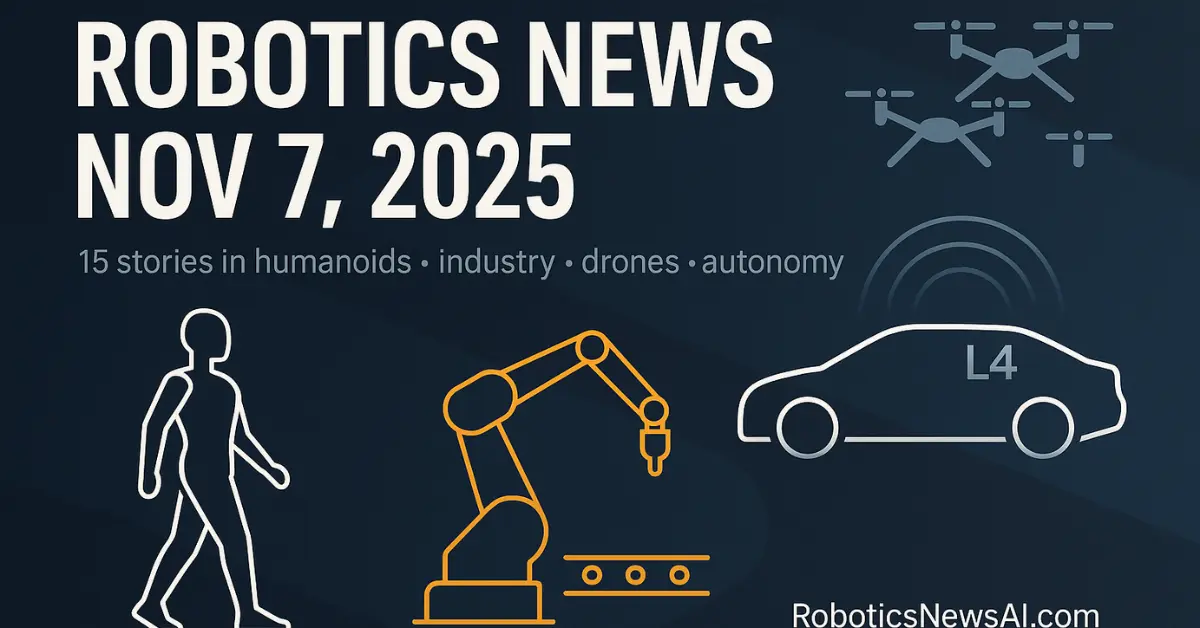Table of Contents
Welcome to ROBOTICS NEWS November 7, 2025 your weekly roundup of the most important robot, AI-mech, and autonomy updates from around the world
1)Toyota’s “Walk Me” – Four-Legged Robotic Chair That Walks and Climbs Stairs
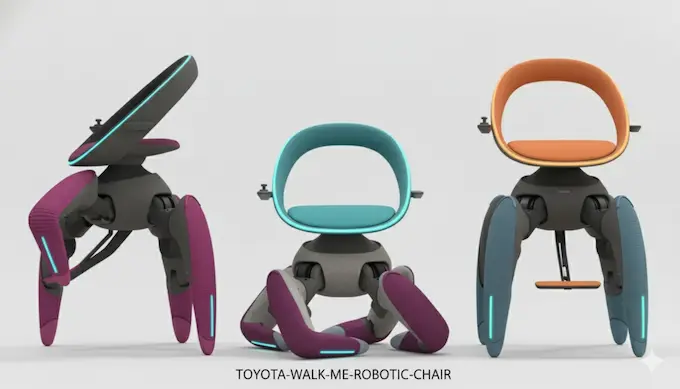
Story
Toyota has introduced a revolutionary mobility concept called “Walk Me” at the Japan Mobility Show 2025, running from October 30 to November 9 in Tokyo. This four-legged autonomous chair replaces traditional wheels with robotic limbs that can walk, climb stairs, and navigate uneven terrain. The device is designed to help people with reduced mobility overcome barriers that conventional wheelchairs cannot handle.
Key Features:
- Four independent robotic legs covered in soft, pastel-colored material that can bend, lift, and adjust individually
- LiDAR sensors and cameras continuously scan surroundings to navigate obstacles
- Weight sensors ensure user stability before major movements
- Voice control capabilities (“kitchen,” “faster”) and manual side handles
- Folds into carry-on size within 30 seconds for easy transport
- Curved ergonomic backrest that supports the spine
How It Works: When climbing stairs, the front legs test the step height and pull the chair upward while the rear legs generate thrust and support. The system is inspired by goats and crabs, animals known for sure-footed navigation of challenging terrain. The chair can also lower itself to floor level for social interactions and lift users to car door height for easy transfers.
Why It Matters: This innovation addresses everyday challenges faced by people with mobility limitations, from Japan’s elevated homes and narrow hallways to outdoor garden paths. It represents Toyota’s “Mobility for All” philosophy and could revolutionize assistive technology by eliminating dependence on ramps, elevators, and accessible infrastructure. Current Status: Prototype/concept stage with no announced production timeline
Source: Interesting Engineering; TechEBlog. Interesting Engineering+1
2) Chinese military tests robot dogs and FPV drones in amphibious drill near Taiwan

PLA Conducts Amphibious Landing Exercise Integrating Four-Legged Robot Dogs with FPV Drone Swarms
Story
On October 28, 2025, China’s People’s Liberation Army (PLA) aired footage of an amphibious landing drill near Taiwan that showcased the integration of four-legged robot dogs and multiple classes of aerial drones. The exercise, broadcast by state media CCTV, demonstrates Beijing’s rapid progress in manned-unmanned teaming for contested littoral operations.
Latest Updates in ROBOTICS NEWS November 7
- Robot dogs loaded with explosives sprint across beach obstacles, ditches, and barricades
- First-person view (FPV) drones provide fire suppression and strike enemy positions
- Reconnaissance drones monitor battlefield and identify enemy locations
- Additional robot dogs serve as ammunition carriers for dispersed troops
- Exercise simulated beach assault following damage to amphibious armored vehicles
Latest Developments in ROBOTICS NEWS November 07
Tactical Concept: The scenario shows robot dogs deployed in the first wave of landing forces to clear passages through defensive lines. Specialized drone units operate FPV craft to strike fortified positions while autonomous quadrupeds navigate obstacles. The exercise revealed a “detection to destruction” cycle of under 10 seconds.
Limitations Exposed: Despite the sophisticated integration, the drill also revealed vulnerabilities. Defending forces successfully shot down robot dogs traversing open ground, and FPV drones failed to significantly weaken fortified positions. The documentary showed that beach defenses were only cleared after infiltration teams launched rear attacks, ultimately requiring soldiers to manually place explosive charges under fire—resulting in “heavy casualties,” according to exercise commander Ren Mengqi.
Why It Matters: This confirms the rapid militarization of small ground robots and low-cost drones for amphibious assault operations. The PLA is normalizing unmanned systems as part of routine capabilities around Taiwan, though the exercise also demonstrates that human forces remain essential when autonomous systems are suppressed.
Context: This follows the PLA’s April 2025 “Strait Thunder-2025A” exercise and represents an escalation in unmanned warfare capabilities.
Source: Army Recognition. Army Recognition
3) Report: China uses ‘wolf robots’ in a live-fire Taiwan landing simulation

Story 3: China Deploys “Wolf Robots” in Live-Fire Taiwan Landing Simulation
China’s 72nd Group Army Tests AI-Driven “Wolf Robots” in First Public Combat Assault Role
Story
China’s PLA Eastern Theater Command conducted a major training exercise featuring 70kg four-legged “wolf robots” in simulated Taiwan invasion scenarios. This marks the first public display of autonomous ground robots performing spearhead assault roles traditionally held by soldiers at extreme risk during beach landings.
Robot Specifications:
- Weight: 70 kilograms
- Payload capacity: 20 kilograms
- Equipped with five cameras for 360-degree situational awareness
- Built for reconnaissance, supply transport, and precision attacks up to 100 meters
- Developed by China South Industries Group
Operational Capabilities: Single operators demonstrated control of nine wolf robots and six drones simultaneously using real-time 3D battlefield interfaces. The robots cleared barbed wire and trenches in 3-5 minutes. The integration of manned and unmanned elements reportedly expanded combat radius four times compared to standard infantry squads.
Combat Performance: Attack-type wolf robots worked alongside swarms of FPV suicide drones in coordinated strikes against mock enemy fortifications. The exercise demonstrated rapid engagement cycles, with time “from detection to destruction” reduced to under 10 seconds. Transport variants followed assault robots, carrying ammunition and supplies.
Why It Matters: This represents China’s strategic push to replace human troops in dangerous frontline operations with AI-driven, unmanned systems. The robots were unveiled at China’s September 3 military parade and represent a significant capability leap in robotic warfare systems designed specifically for amphibious assault scenarios.
Strategic Context: Part of broader PLA modernization emphasizing unmanned, intelligent warfare as outlined in China’s 14th Five-Year Plan.
Source: Korea JoongAng Daily. Korea Joongang Daily
4) Xpeng unveils navigation-free driving and L4 robo-car plan; Volkswagen named as first partner
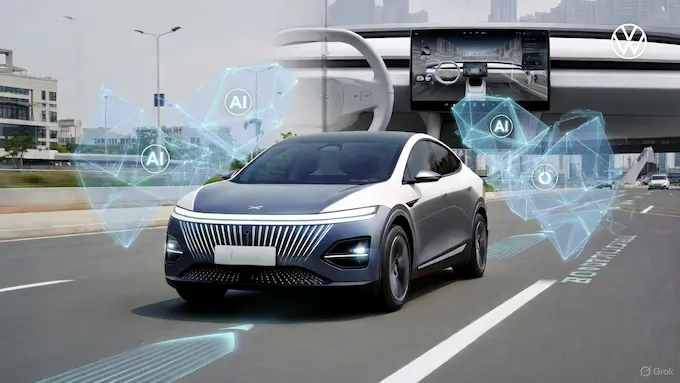
Xpeng Announces Vision-Only L4 Autonomous Driving System, Names Volkswagen as First Partner
Story
At its 2025 AI Day on November 5, Xpeng unveiled its second-generation VLA (Vision-Language-Action) model and announced plans for navigation-free autonomous driving and L4-level robotaxis. German automaker Volkswagen was confirmed as the first strategic partner to use Xpeng’s advanced autonomous driving technology.
Second-Generation VLA Model:
- Trained on nearly 100 million video clips covering 65,000 years of driving scenarios
- 72 billion parameters powered by 30,000 GPU cloud computing cluster
- Direct “Vision-Implicit Token-Action” pathway, eliminating language translation bottleneck
- Real-time performance with 2,250 TOPS compute power
- Open-sourced to global commercial partners
Navigation-Free Driving: The industry-first “Navigation-Free Assisted Driving” (Super LCC+) can operate globally without relying on HD maps or navigation systems. The system recognizes pedestrian gestures for “wave-to-stop” functionality and understands traffic light logic. Pioneer testing begins late December 2025, with full rollout in Q1 2026 on Ultra models (P7 Ultra and G9 Ultra).
L4 Robotaxi Plans: Xpeng will launch three purpose-built robotaxi models (5-seat, 6-seat, and 7-seat) in 2026 with:
- Four Turing AI chips delivering 3,000 TOPS
- Dual hardware for redundancy
- Vision-only approach (no LiDAR)
- Trial operations starting in Guangzhou
- Sun-visor external display to communicate with pedestrians
- Open SDK for global partners (Amap confirmed as first partner)
Consumer “Robo” Version: Xpeng will offer a consumer-grade “Robo” experience version on select models in 2026, featuring the same L4 hardware/software as robotaxis with two driving modes.
Volkswagen Partnership: This marks the sixth collaboration between Xpeng and VW. Volkswagen will license Xpeng’s XNGP autonomous driving solution for its China EVs starting in 2026, with Xpeng’s Turing AI chips selected for use in VW vehicles. The technology will be deployed on two jointly-developed mid-size SUVs launching in 2026.
Why It Matters: If successful, “map-light” or navigation-free autonomy could dramatically reduce the cost and complexity of deploying autonomous vehicles at scale by eliminating dependence on expensive HD mapping. Xpeng claims its system requires less human intervention than Tesla’s FSD and completed test routes several minutes faster.
Source: CarNewsChina. CarNewsChina.com
5)A $20K humanoid robot promises to tidy your home — with caveats

Consumer-Priced Humanoid Robots Edge Toward Reality as ~$20K Home Assistant Platforms Emerge
Story
Consumer coverage has highlighted a new wave of humanoid robots priced around $20,000 being pitched for household tasks, including tidying and cleaning. While these represent a significant price reduction from industrial humanoid platforms, experts note that substantial limitations and “strings attached” remain before these robots can reliably perform complex home tasks.
Market Context: The consumer humanoid robot market is rapidly evolving, with multiple companies racing to bring affordable platforms to market. The ~$20,000 price point represents approximately 10% of the cost of early industrial humanoids, making the technology accessible to early adopter households and small businesses.
Capabilities and Limitations: Current consumer humanoid platforms can perform basic manipulation tasks like picking up objects, organizing items, and simple cleaning operations. However, they typically require:
- Structured environments with clear pathways
- Specific types of objects they’ve been trained to recognize
- Supervision during initial operation periods
- Regular charging cycles (typically 2-4 hours of operation)
- Software updates to expand task libraries
Industry Perspective: The rapid price reduction indicates aggressive competition in the humanoid robotics space, with Chinese manufacturers leading cost optimization efforts. However, experts caution that performing reliable household tasks requires solving complex manipulation, perception, and decision-making challenges that remain active areas of research.
Why It Matters: The emergence of sub-$25,000 humanoid robots signals that household-class robotics are transitioning from research labs to consumer products. While current limitations mean these are best suited for early adopters willing to work within constraints, the trajectory suggests increasingly capable home assistants within 2-3 years.
Looking Ahead: Industry analysts expect the home humanoid market to expand rapidly between 2025-2027, with prices potentially dropping to $10,000-$15,000 as production scales and competing platforms emerge from Chinese, US, and European manufacturers.
6) Capgemini & Orano deploy “first intelligent humanoid robot” in nuclear sector

Nuclear Industry Pilots Humanoid Robot for High-Risk Inspection and Manipulation Tasks
Story
French nuclear group Orano and technology consulting firm Capgemini announced the deployment of what they’re calling “the first intelligent humanoid robot in the nuclear sector” in November 2025. The initiative targets high-radiation and hazardous areas where human workers face significant safety risks.
Deployment Context: Nuclear facilities present unique challenges for robotics due to radiation hardening requirements, complex manipulation tasks, and strict safety protocols. Traditional industrial robots are fixed in place and lack the flexibility to navigate the varied environments found in nuclear plants. Humanoid form factors offer advantages in facilities designed for human workers.
Capabilities: The humanoid platform is designed to perform:
- Visual inspection of equipment in high-radiation zones
- Manipulation of valves, switches, and control interfaces
- Sample collection and transport
- Monitoring of gauges and instrumentation
- Documentation through integrated sensors and cameras
Technical Specifications: While specific details weren’t disclosed, nuclear-rated robotics typically include:
- Radiation-hardened electronics and sensors
- Redundant safety systems
- Real-time teleoperation capabilities
- Autonomous navigation within defined areas
- Secure communication systems compliant with nuclear security protocols
Safety Benefits: Deploying humanoids in nuclear environments reduces worker exposure to radiation and hazardous materials. Tasks that previously required extensive protective equipment and limited exposure time can now be performed remotely or autonomously, improving both safety outcomes and operational efficiency.
Why It Matters: High-risk facilities like nuclear plants, chemical processing sites, and disaster response scenarios are among the most compelling use cases for humanoid robotics. Unlike manufacturing, where specialized fixed robots often suffice, these environments benefit from the flexibility and human-like manipulation capabilities of humanoid platforms. Success in nuclear deployments could accelerate adoption in other hazardous industries.
Industry Impact: This deployment represents a significant milestone for humanoid robotics moving from controlled industrial settings to complex, high-stakes operational environments. It validates the humanoid form factor for specialized applications where human-like dexterity and mobility are essential.
Source: Orano (newsroom). orano.group
7) Neuralink surgeon hints “very soon” for robot-human interface milestones
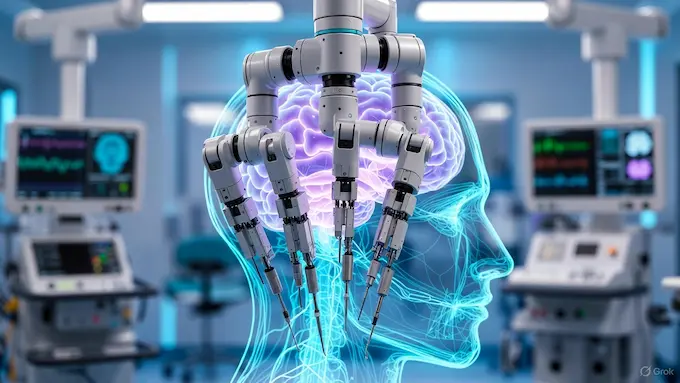
Neuralink’s Head of Surgery Teases Near-Term Breakthroughs in Robot-Assisted Neural Interfaces
Story
Neuralink’s Head of Surgery has suggested that significant progress in robot-assisted human interface technology will come “very soon,” according to coverage by Futurism. The comments point to advancing capabilities in both brain-computer interface (BCI) implantation and potential integration with robotic systems for rehabilitation and prosthetic control.
Current Neuralink Status: Neuralink has been conducting human trials of its brain-computer interface system, which involves precisely implanting thousands of electrode threads into the brain using a custom surgical robot. The company has demonstrated:
- First human patient controlling computer cursor with thoughts
- Surgical robot capable of inserting flexible electrode threads
- Wireless data transmission from implanted devices
- Real-time neural signal processing
Robot-Human Interface Convergence: The surgical hints suggest multiple potential developments:
- Enhanced surgical robot capabilities for more precise implantation
- Integration of BCI technology with robotic prosthetics for natural control
- Direct neural control of humanoid robots or exoskeletons
- Rehabilitation systems combining BCI feedback with robotic assistance
Technical Challenges: Brain-computer interfaces face ongoing challenges including:
- Long-term biocompatibility of implanted electrodes
- Signal stability and bandwidth limitations
- Surgical precision and safety
- Processing complex neural signals in real-time
- Regulatory approval pathways
Potential Applications:
- Restoring motor function to paralyzed patients
- Advanced prosthetic limb control with tactile feedback
- Rehabilitation following stroke or spinal injury
- Enhanced human-robot collaboration in industrial settings
- Assistive technologies for neurodegenerative conditions
Why It Matters: Brain-computer interfaces combined with surgical robotics could revolutionize treatment for paralysis, amputation, and neurological conditions. The technology has potential to restore independence to millions of people worldwide. However, ethical considerations around neural augmentation, privacy of neural data, and long-term safety require careful consideration.
Industry Context: Neuralink faces competition from established medical device companies and academic research groups, but its integrated approach combining custom surgical robots, flexible electrodes, and advanced signal processing represents one of the most comprehensive BCI development efforts.
Source: Futurism. Futurism
8) Circus CA-1 cooking robots cut labor by up to 95% in REWE “Fresh & Smart” stores
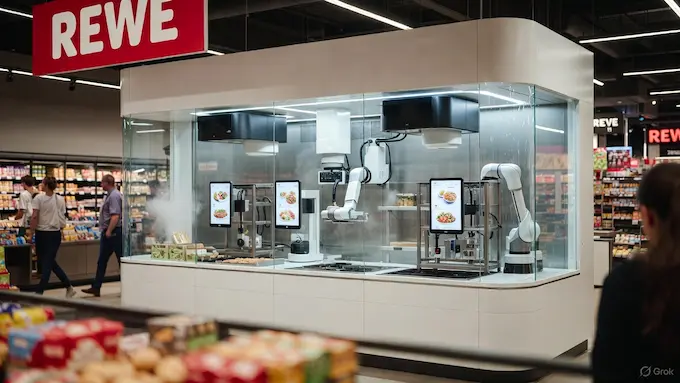
Autonomous Cooking Robot Operates 24/7 in Retail with Just One Hour Daily Human Input
Story
German grocery chain REWE is rolling out Circus SE’s CA-1 autonomous cooking robots across its “Fresh & Smart” store format. The system operates continuously with approximately one hour of daily human oversight, representing a 95% reduction in traditional kitchen labor requirements.
CA-1 System Overview: The Circus CA-1 is a fully autonomous robotic kitchen capable of preparing complete meals without human intervention during operation. The system integrates:
- Automated ingredient handling and storage
- Precision cooking with multiple temperature-controlled zones
- AI-driven recipe execution and quality control
- Self-cleaning capabilities
- Inventory monitoring and ordering
Operational Model: Human staff spend roughly 1 hour daily:
- Loading fresh ingredients
- Performing quality checks
- Cleaning oversight
- Handling customer service
- Managing inventory alerts
The robot then operates autonomously for the remaining 23 hours, preparing meals on-demand based on customer orders. This enables:
- 24/7 food availability
- Consistent quality and portion control
- Reduced food waste through demand-based preparation
- Lower labor costs and staffing challenges
REWE Fresh & Smart Integration: The retail format combines:
- Automated checkout systems
- Small-footprint stores (500-800 square meters)
- Focus on fresh, prepared foods
- Technology-forward customer experience
- Extended hours with minimal staff
Why It Matters: Autonomous food preparation hits mainstream retail, reshaping labor models and in-store kitchen design. This represents one of the most significant deployments of service robotics in European retail, potentially setting precedent for rapid adoption across the sector.
Market Impact: The food service industry faces persistent labor shortages and rising wage pressures. Autonomous cooking systems offer retailers a path to maintain fresh food offerings without dependence on scarce kitchen staff. Success at REWE could trigger widespread adoption across European grocery chains and quick-service restaurants.
Technology Maturity: Unlike experimental robotic restaurants, the REWE deployment represents proven technology operating in real commercial environments. The 95% labor reduction claim suggests the system has achieved sufficient reliability and autonomy for mainstream retail deployment.
Source: Supply Chain Digital (Technology). Supply Chain Digital
9) AgiBot deploys real-world reinforcement learning (RW-RL) on a pilot production line
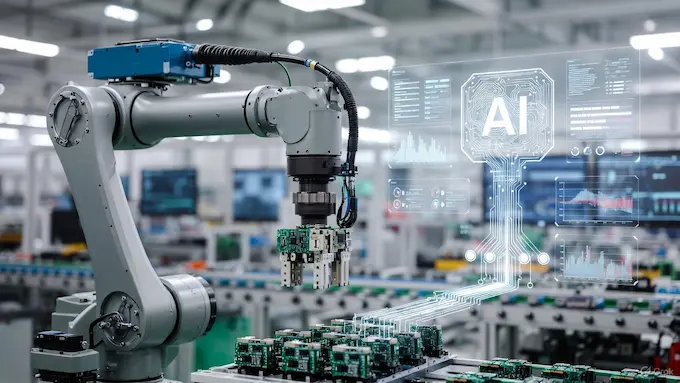
First-Ever Real-World RL Application: AgiBot Robot Learns Directly on Factory Floor
Story
Chinese robotics company AgiBot has achieved what’s being called a major breakthrough in industrial robotics – the first successful deployment of real-world reinforcement learning (RW-RL) on an active production line. The pilot project with electronics manufacturer Longcheer Technology demonstrates robots learning and adapting on the actual factory floor rather than in simulation.
RW-RL Breakthrough: Traditional industrial robots require:
- Extensive pre-programming
- Controlled environments
- Significant downtime for reprogramming
- Limited adaptability to variations
AgiBot’s RW-RL system enables:
- Learning new tasks in minutes instead of days/weeks
- Adaptation to part tolerances and variations in real-time
- Continuous improvement during production
- Minimal downtime when switching between product lines
- Low hardware changeover costs for new tasks
Technical Innovation: The system combines:
- On-device learning algorithms that operate on production hardware
- Real-time feedback from production outcomes
- Safety constraints that prevent damaging actions during learning
- Transfer learning from simulation environments
- Continuous data collection to improve performance
Pilot Results: According to reports, the system achieved:
- Task learning in minutes rather than hours or days
- Stable continuous operation
- Successful handling of part tolerances and variations
- Reduced engineering time for new product introductions
- Maintained quality standards during learning phase
Implementation at Longcheer: The electronics assembly line pilot focuses on:
- Component placement and manipulation
- Quality inspection integration
- Adapting to manufacturing tolerances
- Handling product variations
- Coordinating with existing automation
Why It Matters: Real-world reinforcement learning represents a fundamental shift from programming robots to teaching them. If proven reliable at scale, RW-RL could:
- Slash deployment time for new automation projects
- Enable flexible, multi-product manufacturing lines
- Reduce dependence on robotics integration specialists
- Lower barriers to automation for small manufacturers
- Accelerate the pace of manufacturing innovation
Industry Implications: This moves beyond the traditional “sim-to-real” transfer approach that has dominated robotics research. By learning directly in production environments, robots can handle the messiness and variation of real-world manufacturing that simulations struggle to capture.
Challenges Ahead: While promising, real-world learning faces hurdles:
- Safety certification for learning systems
- Quality control during learning phases
- Integration with existing manufacturing systems
- Proving reliability across diverse applications
Scaling beyond pilot deployments
Source: GizmoChina (also widely reported in robotics press). Gizmochina
10)Johns Hopkins—Lifesaving AI for Search & Rescue Robots
Johns Hopkins Researchers Accelerate Lifesaving AI to Help Robots Navigate Disasters
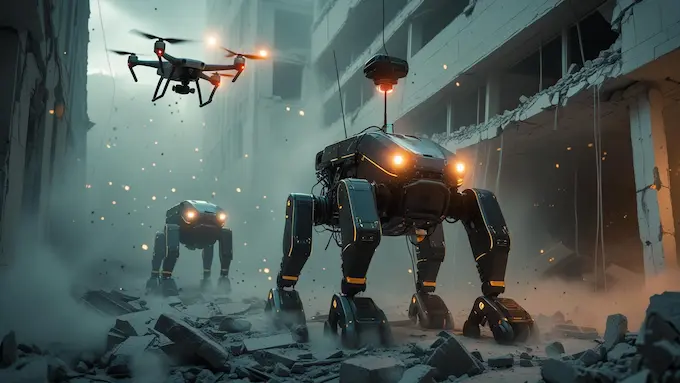
Story
Johns Hopkins highlights new AI efforts aimed at lifesaving applications—bringing together perception, planning, and human-in-the-loop controls so ground and aerial robots can search hazardous areas, triage victims, and deliver supplies. The work emphasizes dependable autonomy in real-world conditions, with training pipelines that translate from simulation to field tests. new 6 altered news for addition…
Key Features:
• Focus on lifesaving tasks (search, triage, delivery) under uncertainty
• Perception-first pipeline using multi-sensor inputs (RGB, depth, LiDAR)
• Human-in-the-loop supervision for safety-critical decisions
• Sim-to-real validation and pilot evaluations with responders
• Modular stack for ground robots (incl. quadrupeds) and drones
How It Works
A layered system fuses onboard sensing for robust mapping, then plans safe trajectories and recovery behaviors when vision is degraded by smoke, dust, or low light. Task-specific policies help robots assess scenes, identify people, and coordinate with operators using readable status cues.
Why It Matters
Disaster scenes are dynamic and dangerous; resilient autonomy can reduce responder risk and cut time-to-aid—turning robotic platforms into practical lifesaving teammates.
Current Status
Active research with pilots; broader field deployments anticipated as models and validation datasets mature.
11)Industrial—Welding Robots Take First Steps in Shipyards
Shipyard Welding Robots Begin On-Site Trials to Improve Quality and Safety
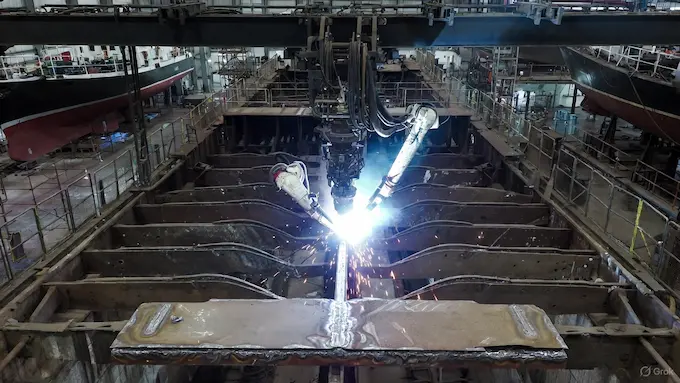
Story
Industry coverage points to welding robots entering shipyard trials, aiming to boost weld consistency on curved, large steel sections while improving worker safety and throughput. These systems are designed to tolerate vibration, fit-up variation, and weather—key hurdles outside factory floors. new 6 altered news for addition…
Key Features:
• Adaptive weld paths for thick, curved hull plates
• Sensor-guided seam tracking under vibration and fit-up variance
• Environmental hardening for wind, humidity, and temperature swings
• Operator handoff modes for setup, inspection, and exceptions
• Targets quality, safety, and takt time improvements
How It Works
Multi-axis arms ride guided rails or mobile bases. Vision + arc sensors detect joint geometry and feeding conditions, adjusting speed, current, and torch angle in real time for continuous, defect-minimizing seams.
Why It Matters
Shipyards are one of the hardest automation environments. Robust weld automation can save rework, raise safety, and reduce skill bottlenecks as order books grow.
Current Status
Field trials; scaled deployment dependent on reliability metrics and ROI confirmation.
12)Research—Teaching Robots to Map Large Environments (MIT)
MIT Unveils Methods to Help Robots Map and Navigate Very Large Spaces

Story
MIT reports new techniques for mapping and exploration across large-scale buildings and campuses, focusing on long-horizon memory, data association, and efficient loop closure so service robots can keep track of where they’ve been without getting lost. new 6 altered news for addition…
Key Features:
• Long-horizon mapping with improved loop closure
• Memory-efficient representations for big spaces
• Robust data association in repetitive corridors
• Works with mobile platforms (indoor/outdoor)
• Emphasis on real-world datasets and benchmarks
How It Works
A hierarchical SLAM stack compresses and filters landmarks while a planner chooses exploration goals that reduce uncertainty. The system revisits key areas to lock in loops and maintains a map that’s compact enough for embedded processors.
Why It Matters
Hospitals, airports, and warehouses are huge. Better large-scale mapping cuts maintenance, increases uptime, and makes “set-and-forget” robot fleets viable.
Current Status
Published methods with demos; integration into commercial stacks likely via open-source and partner projects.
Source:https:
13) Autonomy—XPENG AI Day Shows Model for Robots, Robotaxis, and eVTOLs
XPENG Reveals New AI Model Aimed at Robots, Robotaxis, and Flying Cars
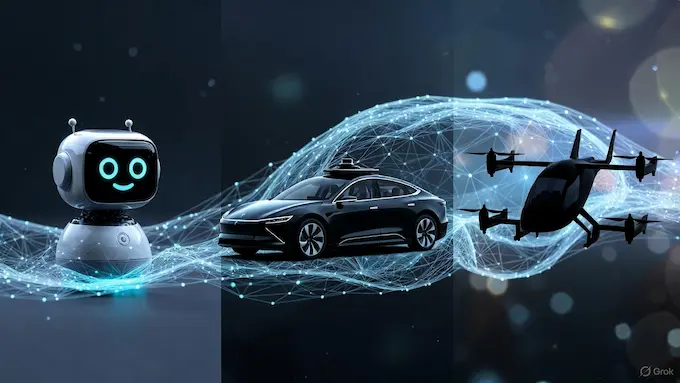
Story
At XPENG AI Day, the company previewed an AI model intended to power multiple product lines—from consumer robots to robotaxis and future eVTOLs—hinting at multi-domain perception, planning, and control unified under one stack. new 6 altered news for addition…
Key Features:
• Multi-domain foundation model for ground/air mobility
• Map-light autonomy emphasis for wider scaling
• Shared perception + planning layers across products
• Potential co-training on diverse sensor suites
• Demo clips teased robot and robotaxi capabilities
How It Works
A shared backbone fuses camera/radar/LiDAR (as available) to produce scene understanding and policies. Domain adapters tune outputs for robots, cars, and eVTOL control loops.
Why It Matters
Unifying models across product lines can cut engineering duplication and speed feature transfer—key for fast iteration in autonomy.
Current Status
Technology showcase; timelines and deployment specifics TBD.
14)Health Tech—WiM Kids Walking-Assist Robot Wins CES 2026 Award
WiRobotics’ WiM Kids Walking-Assist Wearable Wins CES 2026 Innovation Award
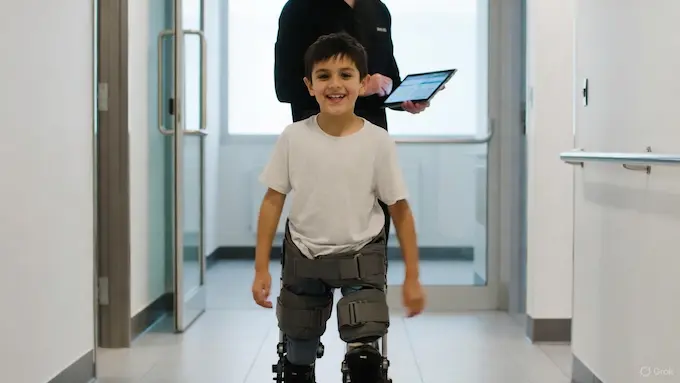
Story
WiRobotics announced its pediatric walking-assist wearable, WiM Kids, earned a CES 2026 Innovation Award in Digital Health. The lightweight device supports gait training with adjustable actuation and sensor feedback designed for growing children. new 6 altered news for addition…
Key Features:
• Pediatric-focused frame with adjustable fit
• Sensor-driven gait detection and assistance profiles
• Lightweight design for comfort and adherence
• Clinician app tools for therapy tuning and progress
• Target: rehab and mobility support for kids
How It Works
Onboard IMUs and force sensors classify gait phases; small actuators assist hip/knee motion per clinician-set parameters. Telemetry supports remote monitoring of therapy sessions.
Why It Matters
Tailored pediatric exos are scarce; a purpose-built system can improve outcomes and enable at-home rehab continuity.
Current Status
Award recognition; commercial rollout, certifications, and clinical study expansion to follow.
Source: Walking-Assist Wearable Robot “WIM KIDS
15) Swarms—Autonomous Drones Guide Fire Evacuations
Coordinated Autonomous Drones Demonstrate Evacuation Guidance for Fire Emergencies

Story
Research coverage describes multi-drone teams that coordinate to guide people through smoke-filled buildings during fires. The system computes safe routes in real time, then uses light or audio cues to shepherd evacuees toward exits, adapting as conditions change. new 6 altered news for addition…
Key Features:
• Multi-drone coordination under low-visibility conditions
• Real-time route planning with dynamic hazards
• Human guidance via light, arrow cues, or audio beacons
• Simulation + hardware trials validating crowd flow
• Potential integration with building sensors (alarms, HVAC)
How It Works
A central planner or distributed consensus assigns waypoints to each drone. Onboard perception detects smoke and obstacles, while guidance cues communicate directional intent to occupants.
Why It Matters
Evacuation is time-critical. Autonomous guidance can reduce confusion and congestion, improving chances of a safe exit.
Current Status
Research prototype; requires regulatory approvals and safety redundancies for real deployments.
Source:Autonomous Drones
Q1. What is the power wheelchair that can go up and down stairs?
Q1. What is the power wheelchair that can go up and down stairs?
A. This edition highlights an experimental “walking chair” concept from Toyota—an electric mobility chair that can raise/lower its seat and use leg-like motions to handle curbs and short stair runs. It’s a prototype aimed at safer indoor-outdoor transitions; broad consumer availability hasn’t been announced yet.
Q2. What is the Chinese military exercise around Taiwan in 2025 mentioned here?
A. We refer to reported large-scale joint drills encircling Taiwan that included air, naval, and drone components. Our summary focuses on the use of swarming drones and electronic warfare noted in official statements and media reports; it’s not an endorsement and timelines/capabilities are subject to change.
Q3. What level of autonomous driving is XPENG right now—and what are they targeting?
A. Today, XPENG’s consumer features are Level 2/L2+ driver-assist (e.g., XNGP) requiring an attentive driver. In this edition, XPENG outlines a Level 4 roadmap for limited areas using “navigation-free” (HD-map-light) AI. Any L4 deployment depends on testing, regulation, and operational geofences.
Q4. What does “real-world reinforcement learning on a pilot line” mean in AgiBot’s demo?
A. Instead of training only in simulation, the robot learns on a controlled factory cell using offline data plus cautious online fine-tuning with safety limits. The goal is faster adaptation to part variations and tasks, while guardrails and supervision keep trial actions safe.
Q5. Are retail cooking robots ready for everyday restaurants?
A. They work best on narrow, repetitive tasks (frying, dispensing, coffee) with standardized menus. ROI hinges on throughput, uptime, and service costs; human oversight is still required for food quality, safety, and exception handling. Adoption is strongest in chains and high-volume sites.

